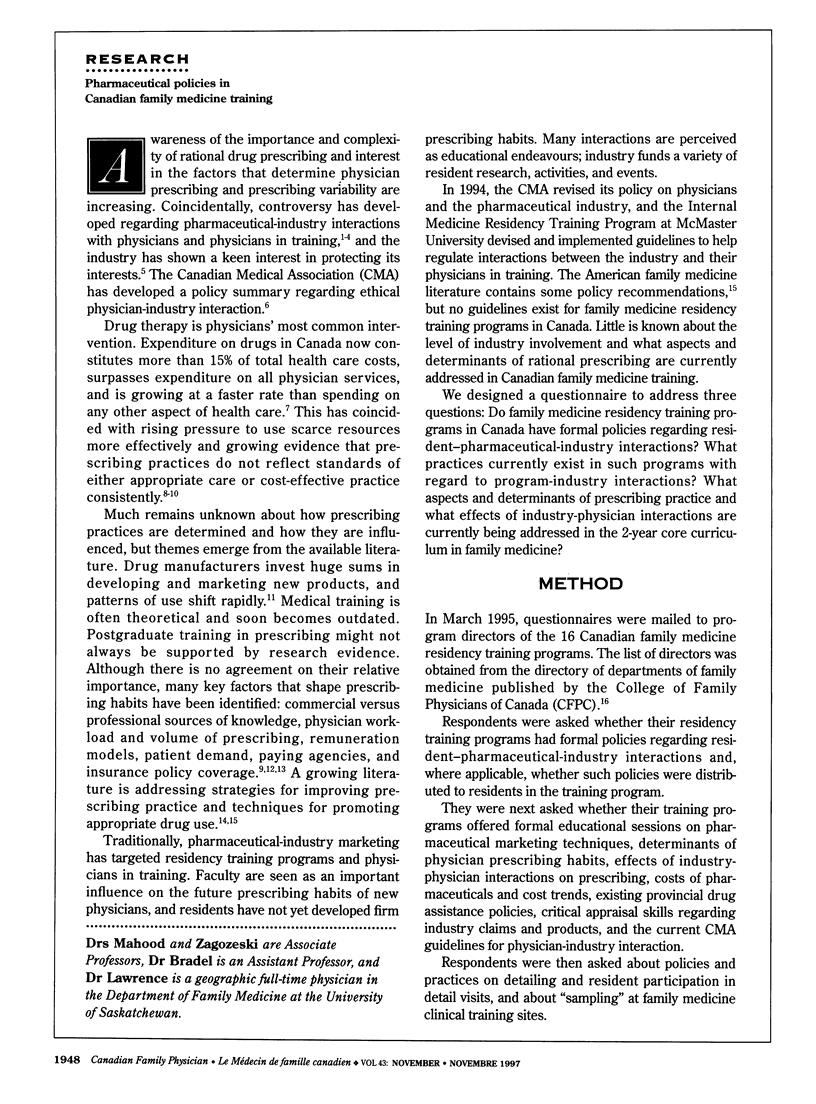Abstract
OBJECTIVE: To determine whether family medicine residency training programs have formal policies regarding interactions between residents and the pharmaceutical industry, to identify existing practices, and to find out what issues in industry-physician interaction are addressed during the 2-year core curriculum training in Canada. DESIGN: Mailed survey using a questionnaire. SETTING: The 16 Canadian residency training programs in family medicine. PARTICIPANTS: Program directors of all 16 Canadian family medicine residency training programs replied. MAIN OUTCOME MEASURES: Number of programs with formal pharmaceutical policies; number of programs offering formal curriculum coverage of related topics in the field; program practices regarding industry sampling, detailing, sponsorship, and access. RESULTS: Only four of the 16 programs have formal policies or guidelines. Topics generally covered in core curriculum included critical appraisal (13/16) and cost trends (11/16). Few programs address determinants of prescribing (5/16), marketing techniques (4/16), provincial drug access programs (6/16), or the Canadian Medical Association guidelines on physician-industry interaction (5/16). Industry presence and sponsorship in family medicine training is notable, and screening is limited. Great variation exists, and programs are interested in future initiatives. CONCLUSIONS: Family medicine training in Canada is attempting to address pharmaceutical issues. Interest is strong, but these issues need to be given more emphasis.
Full text
PDF




Selected References
These references are in PubMed. This may not be the complete list of references from this article.
- Anderson G. M., Lexchin J. Strategies for improving prescribing practice. CMAJ. 1996 Apr 1;154(7):1013–1017. [PMC free article] [PubMed] [Google Scholar]
- Avorn J., Soumerai S. B. Improving drug-therapy decisions through educational outreach. A randomized controlled trial of academically based "detailing". N Engl J Med. 1983 Jun 16;308(24):1457–1463. doi: 10.1056/NEJM198306163082406. [DOI] [PubMed] [Google Scholar]
- Brotzman G. L., Mark D. H. Policy recommendations for pharmaceutical representative-resident interactions. Fam Med. 1992 Aug;24(6):431–432. [PubMed] [Google Scholar]
- Carter A. O., Strachan D., Appiah Y. Physician prescribing practices: What do we know? Where do we go? How do we get there? CMAJ. 1996 Jun 1;154(11):1649–1653. [PMC free article] [PubMed] [Google Scholar]
- Davidson W., Molloy D. W., Somers G., Bédard M. Relation between physician characteristics and prescribing for elderly people in New Brunswick. CMAJ. 1994 Mar 15;150(6):917–921. [PMC free article] [PubMed] [Google Scholar]
- Erola J. A. We need dialogue and discussion, not a new Berlin Wall. CMAJ. 1994 Mar 15;150(6):955–956. [PMC free article] [PubMed] [Google Scholar]
- Guyatt G. Academic medicine and the pharmaceutical industry: a cautionary tale. CMAJ. 1994 Mar 15;150(6):951–953. [PMC free article] [PubMed] [Google Scholar]
- Lexchin J. Relations with the pharmaceutical industry. CMAJ. 1994 Aug 15;151(4):413–415. [PMC free article] [PubMed] [Google Scholar]
- McIsaac W., Naylor C. D., Anderson G. M., O'Brien B. J. Reflections on a month in the life of the Ontario Drug Benefit Plan. CMAJ. 1994 Feb 15;150(4):473–477. [PMC free article] [PubMed] [Google Scholar]
- Squires B. P. Physicians and the pharmaceutical industry. CMAJ. 1993 Nov 15;149(10):1391–1392. [PMC free article] [PubMed] [Google Scholar]


